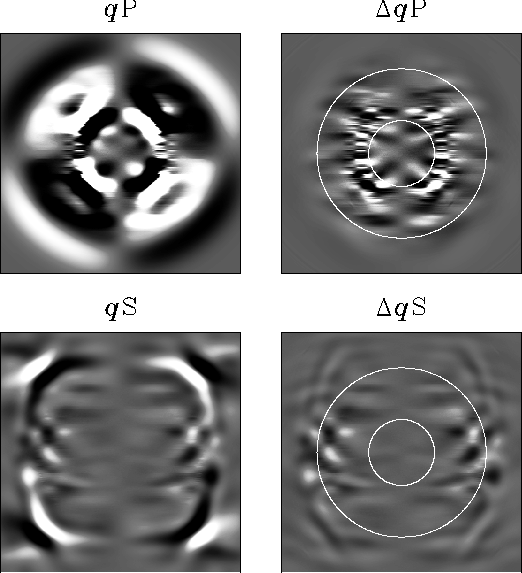




Next: Raising the frequency
Up: SCHOENBERG-MUIR THEORY
Previous: SCHOENBERG-MUIR THEORY
S&M layer averaging works for waves propagating in a stack of flat
layers at any angle (although as we can see in Figure 2, the
zero-frequency approximation can't be pushed as far for waves propagating
along the layers as it can for waves propagating across them).
model
Figure 3
A typical model.
The intensity on this plot shows the value of
 at each gridpoint.
The model is 5122 gridpoints.
The ring is 110 gridpoints across from inner to outer edge.
The source is a vertical point force at the ``*''.
at each gridpoint.
The model is 5122 gridpoints.
The ring is 110 gridpoints across from inner to outer edge.
The source is a vertical point force at the ``*''.

What about a stack of dipping layers?
Schoenberg-Muir theory says nothing about the boundary conditions on the
ends of the layers;
the math assumes infinite flat layers so that the troublesome
ends are infinitely far away and can be ignored. Oblique stacks of layers, like
a canted row of dominos, violate this assumption because
the waves must encounter the edges of the layers
to enter the stack.
(See Figure 1.)
Does this violation of the underlying assumptions cause noticeable effects?
Figure 3 shows a 5122 gridpoint model consisting of a annulus-shaped
set of layers embedded in its homogeneous S&M equivalent medium.
(The layers are chosen the same way as in Figure 2.)
S&M theory tells us that if the wavelength of the source is sufficiently
long, and the edge effects of the layers are ignored, the waves should emerge
from the stack looking the same as they would if the medium
were homogeneous everywhere.
Figure 4 shows the actual results; the qP wave is low
enough in spatial frequency to work nearly perfectly for all angles of
propagation. The main difference is that the amplitude of the qP
wave in the layered model is about 10% lower.
The edge effects do not seem to be significant in this model.
blob
Figure 4
Left: Snapshots of waves propagating in the annulus model shown in
Figure 3. The model is 5122 gridpoints, the annulus
is 110 gridpoints wide, the
qP waves have a wavelength of about 135 gridpoints, and the
qS waves have a wavelength of about 75 gridpoints.
Right: The difference between waves in the S&M equivalent homogeneous
model and the annulus model on the left. The two white circles mark
the edges of the heterogeneous part of the model, where the differing
underlying elastic constants and density between the two models makes
subtracting displacements meaningless.






Next: Raising the frequency
Up: SCHOENBERG-MUIR THEORY
Previous: SCHOENBERG-MUIR THEORY
Stanford Exploration Project
1/13/1998


